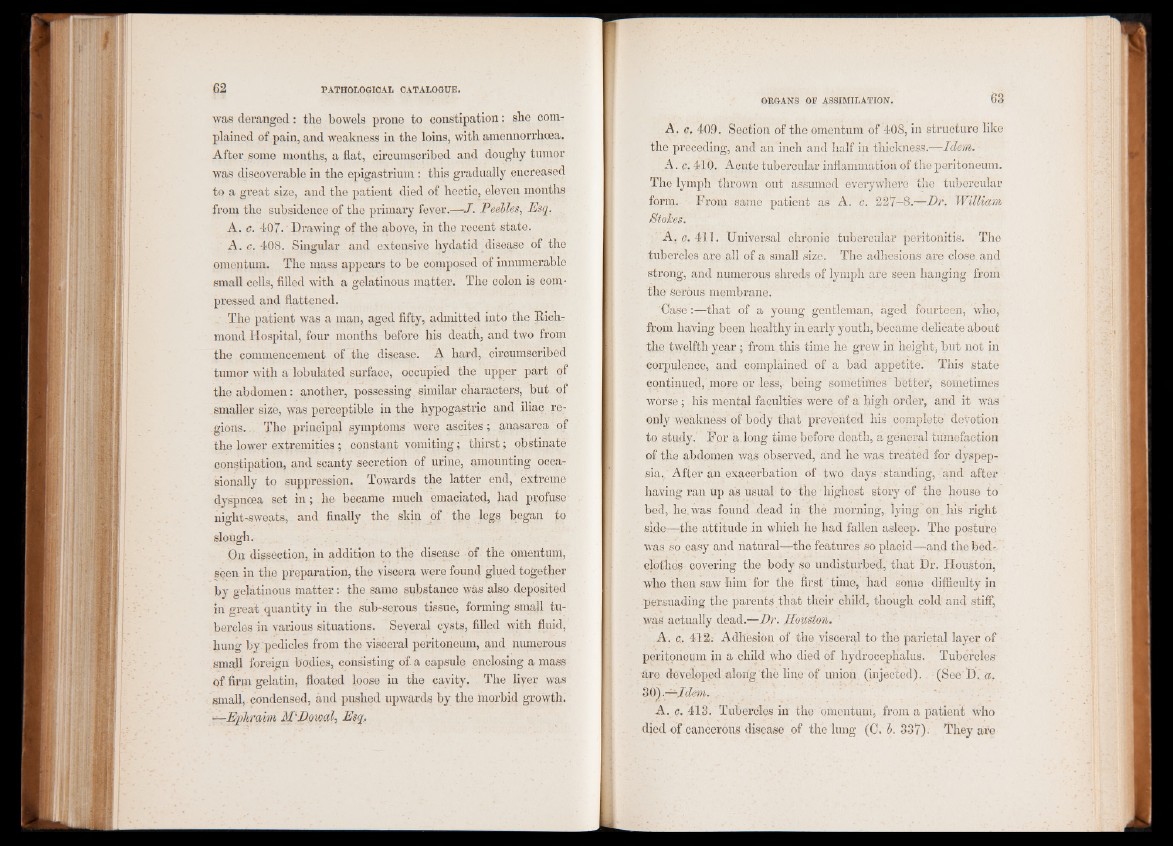
was deranged: the bowels prone to constipation: she complained
of pain, and weakness in the loins, with amennorrhoea.
After some months, a flat, circumscribed and doughy tumor
was discoverable in the epigastrium : this gradually encreased
to a great size, and the patient died of hectic, eleven months
from the subsidence of the primary fever.—J. Peebles, Esq.
A. c. 407. Drawing of the above, in the recent state.
A. c. 408. Singular and extensive hydatid disease of the
omentum. The mass appears to be composed of innumerable
small cells, filled with a gelatinous matter. The colon is compressed
and flattened.
The patient was a man, aged fifty, admitted into the Richmond
Hospital, four months before his death, and two from
the commencement of the disease. A hard, circumscribed
tumor with a tabulated surface, occupied the upper part of
the abdomen: another, possessing. similar characters, but of
smaller size, was perceptible in the hypogastric and iliac regions..
The principal symptoms were ascites; anasarca of
the lower extremities ; constant vomiting; thirst; obstinate
constipation, and scanty secretion of urine, amounting occasionally
to suppression. Towards the latter end, extreme
dyspnoea set in; he became much emaciated, had profuse-
night-sweats, and finally the skin of the legs began to
slough.
On dissection, in addition to the disease of the omentum,
seen in the preparation, the viscera were found glued together
by gelatinous matter: the same substance was also deposited
in great quantity in the sub-serous tissue, forming small tubercles
in various situations. Several cysts, filled with fluid,
hung by pedicles from the visceral peritoneum, and numerous
small foreign bodies, consisting of- a capsule enclosing a mass
of firm gelatin, floated loose in the cavity. The liver was
small, condensed, and pushed upwards by the morbid growth.
tA,Ephraim M H ovjal, Esq..
A. c. 409. Section of the omentum of 408, in structure like
the preceding, and an inch and half in thickness.—Idem.
A . c. 410. Acute tubercular inflammation of the peritoneum.
The lymph thrown out assumed everywhere the tubercular
form. From same patient as A. c. 227-8.—Dr. William
Stokes.
A, c. 411. Universal chronic tubercular peritonitis. The
tubercles are all of a small size. The adhesions are close, and
strong, and numerous shreds of lymph are seen hanging from
the serous membrane.
'Case:—that of a young gentleman, aged fourteen, who,
from having been healthy in early youth, became delicate about
the twelfth year ; from this time he grew in height, but not in
corpulence, and complained of a bad appetite. This state
continued, more or less, being sometimes better, sometimes
worse; his mental faculties were of a high order, and it was
only weakness of body that prevented his complete devotion
to study. Fpr a. long time before death, a general tumefaction
of the abdomen was observed, and he was. treated for dyspepsia,,
After an exacerbation of two days . standing, and after
having ran up as usual to the highest story of the house to
bed, he. was found dead in the morning, lying on his right
side—the attitude in which he had fallen asleep. The posture
was so easy and natural—the features so placid—and the bedclothes
covering the body so undisturbed, that Dr. Houston,
who then saw him for the first time, had some difficulty in
persuading the parents that their child, though cold and stiff,
was actually dead.—Dr. Houston.
A. c. 412; Adhesion of the visceral to the parietal layer of
peritoneum in a child who died of hydrocephalus. Tubercles-
are developed along the line of union (injected). (See D. a.
80y.—Idem. ...
A.c. 413. Tubercles in the omentum, from a patient who
died of cancerous disease of the lung (0. h. 337). They are